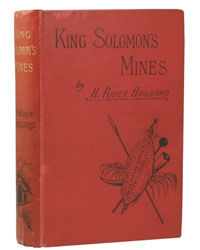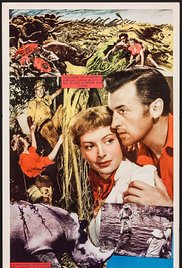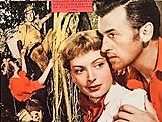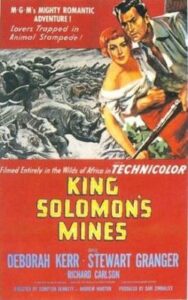King Solomon’s Mines **** (1950, Deborah Kerr, Stewart Granger, Richard Carlson, Hugo Haas, Siriaque) – Classic Movie Review 5,634
MGM’s smoothly made and exciting double Oscar-winning Technicolor 1950 remake of the H Rider Haggard adventure novel King Solomon’s Mines is mostly filmed on spectacular locations in Africa and is graced with ideally cast Stewart Granger and Deborah Kerr.
MGM’s very smoothly made and exciting double Oscar-winning Technicolor 1950 remake of the H Rider Haggard romantic adventure novel King Solomon’s Mines is mostly filmed on spectacular locations in Africa (the Congo, Kenya and Tanzania) and is graced with an ideal cast.
Stewart Granger stars in director Compton Bennett’s 1950 Technicolor adventure film King Solomon’s Mines as the white hunter Allan Quatermain, Deborah Kerr as the heroine Elizabeth ‘Beth’ Curtis and Richard Carlson as her brother Commander John Goode leading a safari across uncharted land in a search for Beth’s lost explorer husband and the legendary diamond mine in Africa.
Siriaque of the Watussi Tribe takes on the role of the guide Umbopa, played by Paul Robeson in the earlier original 1937 British version King Solomon’s Mines. Also in the cast are Hugo Haas as Van Brun aka Smith, Lowell Gilmore as Eric Masters, Kimursi of the Kipsigi Tribe as Khiva, John Banner, and Henry Rowland.
Those ideal performers in their prime come up with the needed lively acting, with Granger particularly at his best. There is the most sprightly direction too by Compton Bennett. And of course Rider Haggard’s story, adapted by Helen Deutsch, provides the spectacular adventure.
However, Haggard’s plot is changed to include a female lead character, so much so that Deborah Kerr has top billing, and it strays even further from the novel than the earlier original 1937 British version King Solomon’s Mines, in which Paul Robeson had top billing as Umbopa, an African king in disguise, but here Umbopa’s importance is much reduced.
Robert Surtees won an Oscar and a Golden Globe for Best Cinematography, Color for his gloriously pretty African jungle Technicolor cinematography and the two editors (Ralph E Winters and Conrad A Nervig) won an Oscar too for Best Film Editing, with the film nominated as Best Picture.
Andrew Marton directed the second-unit filming, which also took place in New Mexico in the US Southwest. Marton replaced Compton Bennett as main director in February 1950, when Bennett fell ill after five months of location filming in Africa.
There were rumours of some of the cast falling out with Bennett, but, if so, that might have been difficulties working with the troublesome Stewart Granger. MGM had wanted Errol Flynn, but he preferred to star in Kim.
It was a tricky logistics job filming on location in Africa as production equipment had to be trucked in with a total travel distance of more than 70,000 miles, using a convoy of Dodge trucks. Filming took place in Africa at Murchison Falls in Uganda; Astrida; Volcano Country and Stanleyville in the Belgian Congo; Tanganyika; and Rumuruti and Machakos in Kenya. The cave scene was shot in the Slaughter Canyon Cave in Carlsbad Caverns National Park and other scenes were at shot nearby Sitting Bull Falls in Lincoln National Forest, both in New Mexico in the US Southwest.
Haas’s scenes were all filmed in the studio with a stand-in used on location.
King Solomon’s Mines premiered in New York City on 9 November 1950 and was released in the US on 24 November 1950.
It was a sensational success as the second highest-grossing film of 1950 in the US and MGM’s most successful film of 1950. The film cost $2.3 million and earned $15.1 million globally, making a recorded profit of $4,049,000. It was the third most popular film at the UK box office in 1951.
It was first filmed in Britain as King Solomon’s Mines (1937) with Paul Robeson and remade as King Solomon’s Mines in 1985 with Richard Chamberlain.
The cast are Deborah Kerr as Elizabeth ‘Beth’ Curtis, Stewart Granger as Allan Quatermain, Richard Carlson as Commander John Goode, Hugo Haas as Van Brun aka Smith, Lowell Gilmore as Eric Masters, Kimursi (credited as Kimursi of the Kipsigi Tribe) as Khiva, Siriaque as Umbopa, Sekaryongo as Chief Gagool, Baziga (credited as Baziga of the Watussi Tribe) as King Twala, John Banner, and Henry Rowland.
© Derek Winnert 2017 Classic Movie Review 5,634
Check out more reviews on http://derekwinnert.com





